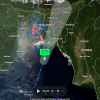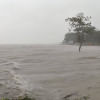Cyclone Sitrang: What to know?
Cyclone Sitrang formed over the east-central Bay of Bengal late night yesterday (October 23, 2022). This is the first big storm that has developed in the Bay of Bengal in the month of October since 2018. It may cross the Bangladeshi coast by early tomorrow (October 25, 2022).
WHICH DISTRICTS ARE MOST VULNERABLE?
At least 19 Bangladeshi coastal districts are at the risk. The Met office in Dhaka said in a bulletin today (October 24, 2022) that the cyclone may cross Barishal-Chattogram region by early tomorrow. Satkhira, Khulna, Bagerhat, Satkhira, Jhalakathi, Pirojpur, Barguna, Patuakhali, Bhola, Barishal, Laxmipur, Chandpur, Noakhali, Feni and three others offshore islands could be the worst hit.
WILL ONLY BANGLADESH BE AFFECTED?
No. Forecasts predict that the cyclone will make its way over Bangladesh and the coast of neighbouring West Bengal tomorrow. The projection indicates that Sundarbans, on both sides of Bangladesh and India (West Bengal) could be the worst-hit. Kolkata, Howrah, and Hooghly in West Bengal would see a moderate amount of rain on Monday and Tuesday. Southern Assam, east Meghalaya, Nagaland, Mizoram, Manipur, and Tripura might get moderate to heavy rainfall, according to India Meteorological Department.
HOW DID SITRANG GET ITS NAME?
It's a Thai name (pronounced as Si-trang). Some say it means 'leaf'.
According to the World Meteorological Organisation, more than one cyclone may form in the same area at once. So, keeping track of them all, tropical storms are all given names. These storms are given names that are simple and memorable to ensure a better communication during a crisis. Usually, regional conventions give tropical cyclones their names. There are four regional Tropical Cyclone Warning Centres and six Regional Specialised Meteorological Centres across the globe. They offer warnings and name cyclones. Of the six, one is the India Meteorological Department. A cyclone with sustained surface winds of 62 kilometres per hour or more is given name when it originates in the northern Indian Ocean.

 For all latest news, follow The Daily Star's Google News channel.
For all latest news, follow The Daily Star's Google News channel. 








Comments